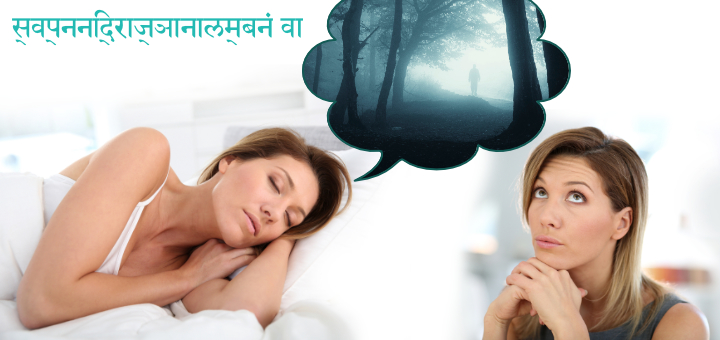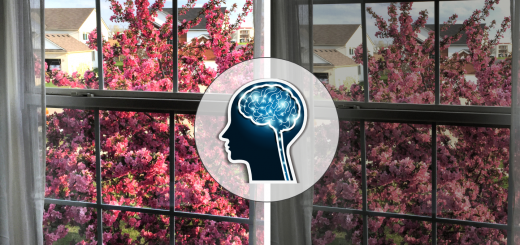Yoga sutras about dreaming and deep sleep
9I am a big fan of Patanjali’s Yoga Sutras – I believe that they are full of insights that can help us better understand our experiences on a daily basis and give us tools to deal with life’s challenges. There is one sutra though that deals with dreaming and deep sleep states that I could never quite understand, and all the commentaries I’ve read I’ve found unsatisfactory.
I am talking about sutra 1.38 Svapna-nidra-jnana-alambanam va, which is often translated as Mental stability also comes from observing dream and deep sleep states. This kind of translation confuses me. How can we observe a deep sleep state if we are unconscious? And remembering our dreams can be quite disturbing, too (as, I am sure, you’ve experienced). How is that supposed to stabilize the mind?
Most commentaries I’ve seen caution us NOT to try to interpret our dreams, but rather to “imagine the peace of deep sleep” (1) or to focus on the “vitality one feels on waking” (2).
All of those commentaries are interpretations, of course, of the original text, so let’s try to translate the sutra word by word to see if we can get any clarity.
Svapna– dream state
Nidra – deep sleep
Jnana – knowledge, study, investigation, observation, experience
Alambanam – having as support for attention, object of concentration
Va – or
This sutra comes in a group of other sutras that describe different strategies we can use to stabilize and focus the mind. “Alambanam va” references that idea, meaning “And another way to achieve mental stability is…” So the main key to this sutra is the word “jnana”, which has a variety of translations and each translation would change the meaning of the sutra. It could be:
“Knowledge that comes from dreams and deep sleep states stabilizes the mind” or
“Study of dreams and deep sleep states stabilizes the mind” or
“Investigation of dreams and deep sleep states stabilizes the mind” or
“Observation of dreams and deep sleep states stabilizes the mind” or
“Experiencing the dreaming and deep sleep states stabilizes the mind”.
This is quite a range! All these translations have different meanings, but they all seem to boil down to the idea that some sort of important knowledge can be gained from either understanding the states of dream and deep sleep or experiencing them. And this would lead to mental stability.
And guess what? Modern neuroscience tells us that both of those are correct. If you understand what is going on in your mind at different stages of sleep and how they alternate throughout the night, you will be aware of the importance of sleep and will be less likely to cut it short. And if you experience a full sleep cycle every night, it has a profound effect on your memory, learning capacity and emotional stability.
So looking at the sutra 1.38 through the prism of modern science we can translate it like this: “Understanding the purpose of dream and deep sleep states and experiencing them fully leads to mental stability.” This translation makes sense to me (of course, this is an interpretation, like any other commentary :)).
Next time we will take a closer look at how different stages of sleep affect those mental functions and how a full-night sleep contributes to mental stability. Tune in!
[jetpack_subscription_form]References
1. The Yoga Sutras of Patanjali by Sri Swami Satchidananda
2. The Essence of Yoga: Reflections on the Yoga Sutras of Patanjali by Bernard Bouanchaud





















This question is nicely answered in the Yoga Sûtra of Patañjali commented by Chip Harttranft, published by . Shambala Classics
Regards
Suman
great commentary on this sutra Olga. I also like this one I have never seen before anywhere, it is from Hareesh ( Christoffer Wallis) what aspect of my being is present in all 3 states of consciousness ( waking, dreaming and deep sleep ) of which I am most familiar. Is there an aspect of my being that is present in all 3 states? “Is there a continuous self that exists in all three states of waking,
dream, and sleep? If not, how can I know that I’ve slept well, or slept ‘like a rock’? If
so, what is the nature of that self which exists in all three states?”
While beneficial sleep is important for the health of the body and the working of the mind, when discussing states of consciousness, “consciousness” itself is the key and there is a continuum of states of consciousness.
Lucid dreaming would be self-awareness within the dream experience whereby the one who is dreaming observes the dreamer in the dream. That would correspond in the waking state to observing the self; the fluctuations of the body (sensations) and mind (thoughts, judgments) with the full awareness of the watcher (higher consciousness), as they occur.
These higher states of consciousness evolve through focus, clearing, learning yogic principles and practices especially from a self-realized teacher (where there is huge transfer of transformative energy) and experiencing at deeper levels of intuition.
The purpose of seeking self-knowledge is to release us from the suffering caused by the fluctuations of the mind. The process of Yoga clears samskaras, and that can happen awake, asleep or in dreams. The clearing activates and balances the energies of the subtle bodies and the chakras in the human energy system.
The self-knowledge that arises from going inward is the synthesis of all of of this, aka, jnana, or wisdom, leading us closer to self-realization. The process of Yoga increases clarity and stability throughout the energy system meaning we see life increasingly from a higher perspective instead of living in the trenches of instability tied to our psychology and emotions.
Put more simply – as consciousness evolves we come to a higher state of consciousness where a presence within us is witnessing the experience, and that releases stuck energy and brings us greater stability and wisdom.
Hi Wendy! Thank you for the lovely summary of what yoga is about. There is no doubt that becoming a witness of our own experience and our mind fluctuations is what we are striving toward. However, I still have trouble translating this sutra as witnessing one’s dream experience because of context. Even if it does become possible at some stage of consciousness development to get to a place where you observe yourself dreaming while you are dreaming; it is certainly not a technique that is easily accessible to novices. Yet all other techniques described before and after this one are fairly easy to do for anyone who is just learning to concentrate. Positive attitude toward others? Prolonged exhalation and suspension of breath? Meditating on the light? – all these are easy to do for anyone and serve as a gateway for deeper levels of concentration. That is why I feel that the sleep sutra should also be translated in a way that is fairly easy for a newbie to practice. This is why I translated it the way I did. And, of course, everyone is welcome to their own interpretation.
Olga, see the translation of the Mandukya Upanishad by Swami Rama Enlightenment Without God about the 4th state, Turiya, which is deep sleep. It is becoming conscious in what is naturally an unconscious state. In other words, Samdhi. Experience of the state of oneness in consciousness. You can also read OM The Eternal Witness another translation of the Mandukya Upanishad by Swami Rama. Both from Himalayan Institute Press. Happy discovery!
Thank you Lisa! Please see my comment to Wendy above – “becoming conscious in what is naturally an unconscious state” seems like quite an advanced technique, while all others around it seem rather simple.
Hi Olga,
I appreciate your comments and mine following may or may not be helpful, but here they are. I studied sleep and dreams from the psychological point of view years ago, and while it is true that science can map brain states, measurements can be made and this is pleasing justification for the Western mind, Yoga is still a holistic practice, not a linear based discipline of strategy and technique. I agree with you that coming to jnana is not easily accessible to novices because there is no specific “technique” that takes you there. I can see where in some interpretations one can find “directions” in the translation of the Sutras, but commentary on the meanings of the Sutras are always about states of being. Practice itself is the process of evolving into higher consciousness, so leading novices to gain confidence in the physical execution or mental comprehension, and then moving them toward deeper awareness of what is going on within them by observing themselves through their sensations, is the goal. Eventually with dedication and consistency, levels deepen and wisdom comes. This is how we bring physical practice and philosophy from a mental understanding into actually living truth from within us. The witnessing happens automatically as we attain states of being where we live in greater truth. For instance, I and others I know have experienced lucid dreaming, some more often than others. While it can be useful, it is not an end in itself.
Consciousness itself is not a practice, although focusing awareness within practice moves consciousness. The Sutras themselves are not a linear progression, as reading a textbook or novel would be and my personal reading of the sutras has been on different levels throughout my years of practice. Some that completely baffled me 20 years ago now make sense, and the meanings of others I thought I understood have changed. Why? Because my self-knowledge and state of consciousness have changed and I’m perceiving them on a different level. Practice itself is not linear because it’s influenced by every aspect of one’s life, as reflected in the fluctuations of the energy system of the chakras and kosas. The whole journey of yoga is the synthesis of one’s life and that journey is rightly called “spiritual.” Without the spiritual journey, there is no realization of the state of “Yoga.”
As seen in the comments on your post, reading different commentaries and translations can be helpful to get what you need from a sutra at that moment, for yourself or to help others.
The translation by Ramamurti S. Misha, M.D. for Sutra 1.38 for example, reads: “Also, meditate on knowledge that comes during sleep in the form of dreams, or deep, dreamless sleep. This Sutra indicates Self-analysis through dream-analysis and analysis of deep sleep.”
Whereas, B.K.S. Iyengar, in “Light on the Yoga Sutras of Patanjali” gives the meaning of individual words followed by this statement: “Or, by recollecting and contemplating the experiences of dream-filled or dreamless sleep during a watchful waking state.” He goes on to illustrate this with his commentary of the four planes of Citta, with the last paragraph illustrating the process of evolving consciousness using asana practice as an example: “The sadhkaka begins his sadhana dreaming of the pros and cons of each asana. This is a svapna (analogous to dream, delusion, judgment-mind) state. He stabilizes his ideas and rests (deeper contemplation and focus on sensation) on them. This is nidra (analogous to sleep state) state. Later he learns to distinguish the subtle points and perform them with awareness. This is the state of jnana (action from the wisdom gained through self-knowledge).” I added the comments seen in ( )’s.
My comments on both of these is the same: No matter the experience, it can be meditated upon in waking state with the possibility of deeper knowing arising from within that adds to the soup of heightening consciousness.
The process of realizing Yoga is really non-negotiable – it is a way of life based in seeking higher consciousness as described in the body of knowledge we know as Yoga. I love this quote by (living) self-realized Yoga Master Sri Madhu Sai – “Living every moment in conscious awareness of every sensory experience that passes through your body is YOGA, and one who lives in that state at all times is a Yogi.”
all the methods that are given in Patanjali I 34 – I-39 are about contemplation or concentration upon one single object.
So I think sutra I 38 is about concentration upon the nature of the deepsleep state and that is not done inside deepsleep , but from the waking state. We can contemplate upon the nature of deep sleep state, how the mind is quiet there and tranquel, with no images and no memories and so on.